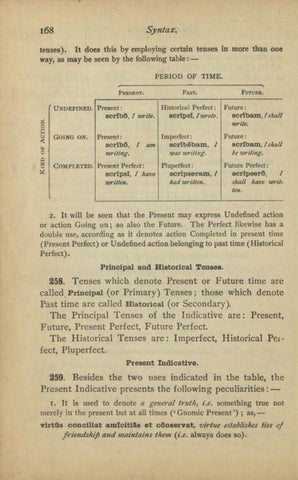Syntax.
168
tenses). It does this by employing certain tenses in more than one way, as may be seen by the following table: PERIOD PRESENT.
OF TIME. FUTURE.
PAST.
UNDEFINED.
Present: scribe, I write.
Historical Perfect: Future: scripsI, I wrote. scribam, I shall write.
GOING ON.
Present: scribe, writing.
Imperfect: 8cribebam, was writi1lg.
1
Pluperfect: scripseram, had written.
I
COMPLETED.
1 am
Present Perfect: scripsi, I have written.
Future:
scrlbam, I shall be writing. Future Perfect:
scrtpsero, I shall have written.
2. It will be seen that the Present may express Undefined action or action Going on; so also the Future. The Perfect likewise has a double use, according as it denotes action Completed in present time (Present Perfect) or Undefined action belonging to past time (Historical Perfect).
Principal and Historical Tenses.
258. Tenses which denote Present or Future time are called. Principal ( or Primary) Tenses; those which denote Past time are called Historical (or Secondary). The Principal Tenses of the Indicative are: Present, Future, Present Perfect, Future Perfect. The Historical Tenses are: Imperfect, Historical Pelfeet, Pluperfect. Present Indicative.
259. Besides the two uses indicated in the table, the Present Indicative presents the following peculiarities:I. It is used to denote a general truth, i,e. something true not merely in the present but at all times (' Gnomic Present') ; as,-
virtue conciliat amIcitia.s et conservat, virtue establishes ties of friendshijJ and maintains them (i.e. always does so).
